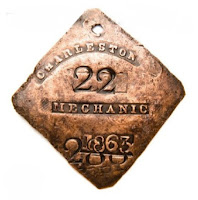I know, I know -- it sounds very touristy to do a tour of Charleston on a horsedrawn carriage. And it was. But there's a reason these tours have become a tradition for people visiting the city. It's a fun (if a bit malodorous) way to learn a bit about the city's history. And so Andrea and I started our girlfriend getaway with a tour given by the Old South Carriage Company. Here are some tidbits I learned along the way.
--While the horses aren't "unionized" (as our guide told us), they are treated well. They are fed 40,000 calories of hay and whatever else horses eat (carrots?) a day. They are given plenty of water and -- here's a surprise -- two pints of Guinness. (The Guinness helps the animals sweat, which cools their bodies down.) They get at least 180 days/year off and spend their free time on a 65 acre farm where they have regularly scheduled dental appointments and massages. Sure, the horses are still working, but it's an easier life than their daily routines were on the Amish farms where they previously lived.
--Given the number of carriage companies in Charleston, you might think pedestrians crossing the street would have to watch carefully where they step. But the City has thought about that issue; hence, the Equine Sanitation Department. Carriage drivers send a text with a GPS marker of each spot where the horse has done its business. Then Doody Calls, the city's contractor, comes out and collects the waste and/or hoses down the area. This was a great technological advancement over the previous system of dropping half a rubber ball with a little flag poking out and calling in the location to the lucky folks responsible for clean-up.
.jpg) |
| Old Slave Mart Museum |
--Remnants of slavery are ever present in Charleston. Take, for instance, the
Old Slave Mart Museum. The building was formerly the home of a slave auction site. It was part of a complex that included a barracoon (an enclosure in which slaves could be held), a slave jail proper, a kitchen and a "dead house" where bodies were stored. It is estimated that more than 10,000 slaves were auctioned off as chattel at this site. While this is a mindboggling number, it's no surprise given that 40% of all enslaved Africans arrived through the port on Charleston Harbor. The International African American Museum is located at the site of the former arrival point.
.jpg) |
| Slave badge |
--Slavery in Charleston was task-based. Under this "progressive" form of slavery, slaves were given a list of tasks each day that they were required to complete. Once those jobs were done, slaves not deemed a flight risk were allowed to spend time with friends and family or to go to the market to purchase goods or sell items they had made. It appears that the enslaved were typically allowed to keep the money they earned in this manner.
--Many slaveowners hired out their slaves to other plantation and business owners. Each worker was required by the City of Charleston to wear a badge specifying that the individual lived in Charleston, his or her occupation, the badge number and the year issued (with annual renewals required). This practice was not only an identifier; it was also a revenue source for the city. And if a slave fled, the information on the badge was included in ads seeking his or her return. For more information on this practice, click
here.
.jpg) |
| Church and Union |
--The term "hushpuppy" has several possible origin stories, but they all refer to cornbread circles carried in pockets to be fed to dogs as a means of distraction. In our guide's version, slaves fed the food to dogs so they wouldn't jump on them and muddy their clothing. Other stories refer to runaway slaves feeding the treat to dogs so they wouldn't bark and give away their location. Ditto for Confederate soldiers hiding from nearby Union soldiers. "Hush, puppies," you can imagine them saying.
--Charleston is known as the Holy City because it boasts 187 churches of various denominations. (This number includes one synogogue and a Hindu temple.) It seems a bit ironic for the city to have been known as a beacon of religious tolerance while simultaneously enslaving people, but the world was and continues to be a complicated place. Surprisingly (not), Andrea and I didn't grace the interior of any churches in use as such, but we did dine at Church and Union. It was delicious if a bit rushed. (Seriously, our food was out approximately three minutes after we ordered it.)
The interior of the restaurant is very cool, with all 12,035 words of "The Art of War" written across its vaulted ceiling by artist Jon Norris. Much of the text is difficult to read due to its placement, but the phrase "There Is Only We" is fairly prominent. I take it as a message of hope.
Our carriage tour was a great way to get an overview of Charleston's history. As a bonus, you pick up the carriages right by Charleston City Market, a four block long covered market with all kinds of goodies to take home as souvenirs. For the record, neither of us brought home a basket, but we did our bit to help the local economy.
Next up: Our visit to McLeod Plantation
.jpg)
.jpg)
.jpg)




.jpg)
.jpg)



.jpg)



.jpg)
.jpg)
.jpg)


.jpg)
.jpg)
.jpg)
.jpg)

